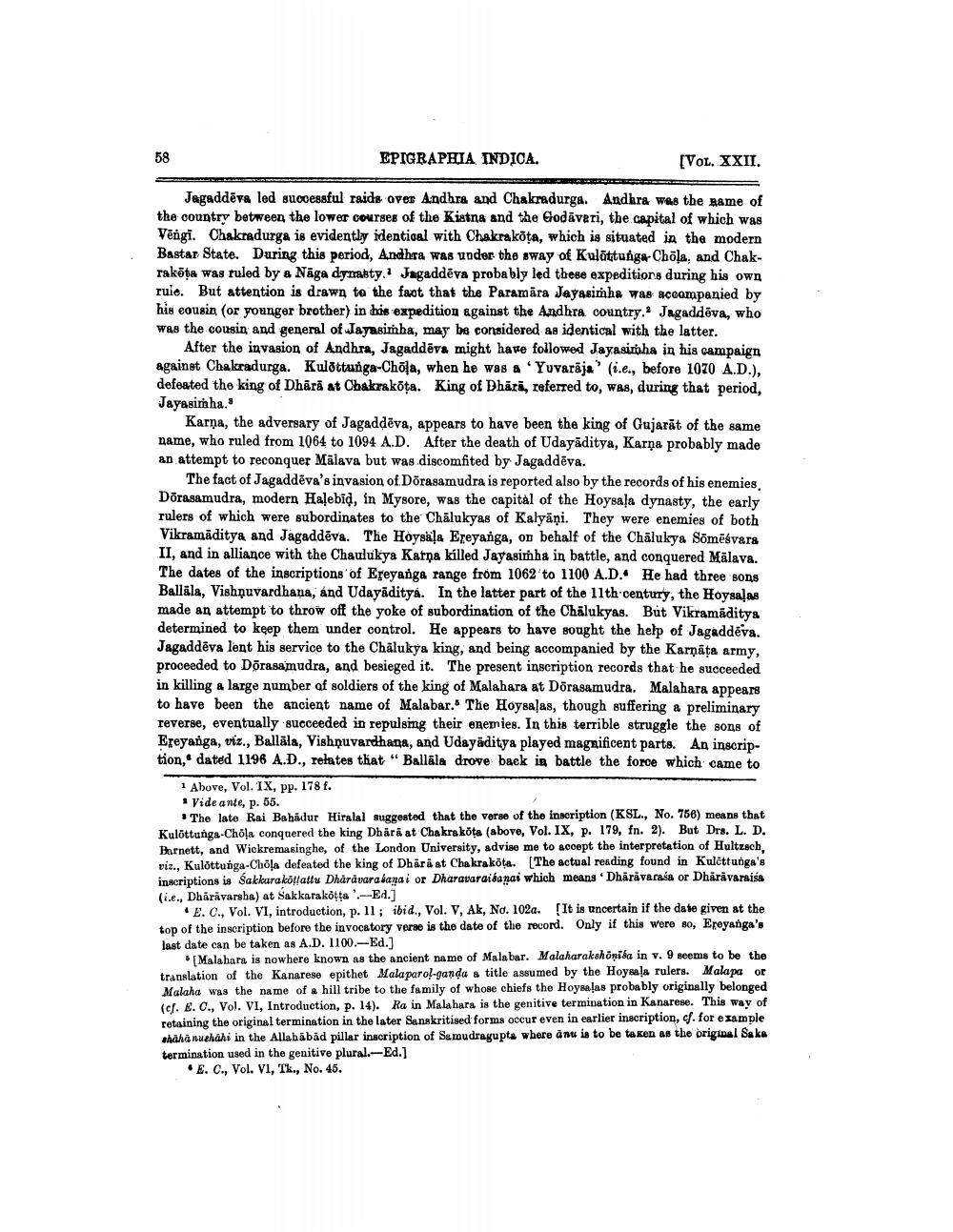________________
EPIGRAPHIA INDICA.
[Vol. XXII.
Jagaddēva led successful raids over Andhra and Chakradurga. Andhra was the name of the country between the lower courses of the Kistna and the Godavari, the capital of which was Vēngi. Chakradurga is evidently identical with Chakrakota, which is situated in the modern Bastar State. During this period, Andhra was under the sway of Kulättunge Chõla, and Chakraköpa was ruled by a Näga dynasty Jugaddeva probably led these expeditions during his own ruio. But attention is drawn to the fact that the Paramāra Jayasimha was accompanied by his eousin (or younger brother) in his expedition &gainst the Andhra country. Jagaddēva, who Was the cousin and general of Jayasimha, may be considered as identical with the latter.
After the invasion of Andhra, Jagaddēva might have followed Jayasinha in his campaign against Chakradurga. Kulttunga-Chola, when he was a 'Yuvarāja' (i.e., before 1070 A.D.), defeated the king of Dhärå at Chakrakota. King of Dhari, referred to, was, during that period, Jayasimha.
Karna, the adversary of Jagaddēva, appears to have been the king of Gujarat of the same name, who ruled from 1964 to 1094 A.D. After the death of Udayāditya, Karņa probably made an attempt to reconquer Mälava but was discomfited by Jagaddēva.
The fact of Jagaddēva's invasion of Dorasamudra is reported also by the records of his enemies. Dorasamudra, modern Halebid, in Mysore, was the capital of the Hoysala dynasty, the early rulers of which were subordinates to the Chalukyas of Kalyäņi. They were enemies of both Vikramaditya and Jagaddēva. The Hoysala Ereyanga, on behalf of the Chālukya Sõmēsvara II, and in alliance with the Chaulukya Karna killed Jayasimha in battle, and conquered Mälava. The dates of the inscriptions of Ereyanga range from 1062 to 1100 A.D. He had three sons Ballāla, Vishnuvardhana, and Udayaditya. In the latter part of the 11th century, the Hoysalas made an attempt to throw off the yoke of subordination of the Chalukyas. But Vikramaditya determined to keep them under control. He appears to have sought the help of Jagaddeva. Jagaddēva lent his service to the Chalukya king, and being accompanied by the Karnāta army, proceeded to Dõrasamudra, and besieged it. The present inscription records that he succeeded in killing a large number of soldiers of the king of Malahara at Dorasamudra. Malahara appears to have been the ancient name of Malabar." The Hoysalas, though suffering a preliminary reverse, eventually succeeded in repulsing their enemies. In this terrible struggle the sons of Ereyanga, viz., Ballăla, Vishnuvardhana, and Udayaditya played magnificent parts. An inscription, dated 1196 A.D., relates that "Ballāla drove back in battle the force which came to
1 Above, Vol. IX, pp. 178 f. Vide ante, p. 55.
The late Rai Bahadur Hiralal suggested that the verge of the inscription (KSL., No. 756) means that Kulottunga-Chola conquered the king Dhåra at Chakrakota (above, Vol. IX, p. 179, fn. 2). But Drs. L. D. Burnett, and Wickremasinghe, of the London University, advise me to accept the interpretation of Hultzsch. vis., Kulottunga-Chöla defeated the king of Dhåra at Chakrakota. The actual reading found in Kulottunga's inscriptions is Sakkara köflattu Dhardvara kagai or Dharavaraibagai which means Dharivarasa or Dhåråvaraisa (i.e., Dharavarsha) at Sakkarakoçta ' -Ed.]
E.C., Vol. VI, introduction, p. 11; ibid., Vol. V, Ak, No. 102a. (It is uncertain if the date given at the top of the inscription before the invocatory verse is the date of the record. Only if this were so, Ereyanga's last date can be taken as A.D. 1100.-Ed.]
[Malahara is nowhere known as the ancient name of Malabar. Malaharakahānika in v. 9 seems to be the translation of the Kanarese epithet Malaparol-ganda a title assumed by the Hoysala rulers. Malapa or Malaha was the name of a hill tribe to the family of whose chiefs the Hoya las probably originally belonged (cf. E.C., Vol. VI, Introduction, p. 14). Ra in Malahara is the genitive termination in Kanarese. This way of retaining the original termination in the later Sanskritised forms oocur even in earlier inscription, cf. for example ahahanushahi in the Allabābåd pillar inscription of Samudragupta where an is to be taken as the original Saka termination used in the genitive plural. Ed.]
E. C., Vol. VI, Tk., No. 45.




